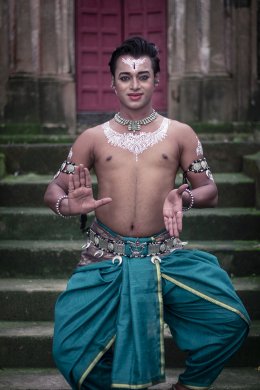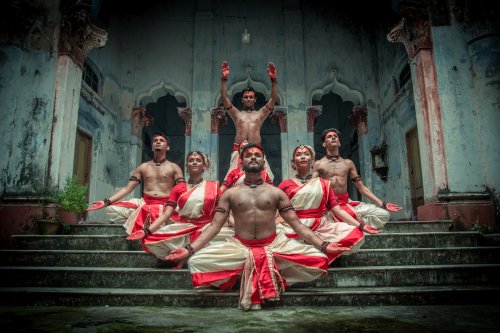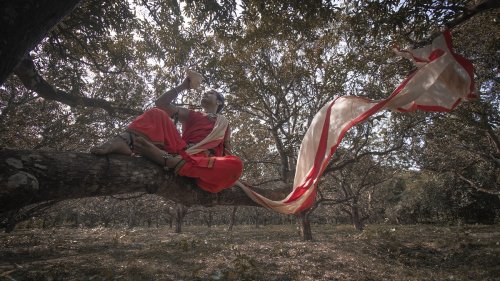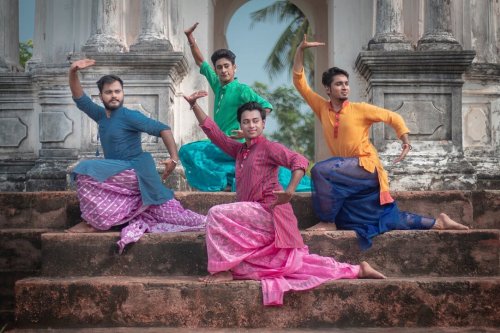
|   |

|   |
 e-mail: ukb7@rediffmail.com Virtual, with visual variety Photos: Pratyush Roy Dasgupta November 22, 2020 Chandika, a form of Parvati's alter ego Durga, represents the power of Shakti who manifested to destroy evil. In Devi Mahatmya, Chandi, Chandika, Ambika and Durga have been used synonymously. Chandi, the most common epithet used for the goddess, is agreed by most scholars to have originated in Bengal, the primary seat of the Shakta or Goddess tradition and tantric worship since ancient times. The basis for Chandi worship is found in Devi Bhagavata as well as in Markandeya Purana containing the well-known Saptashati and narrates the three tales of Chandika, fighting and destroying the six evil forces Madhu and Kaithabha; Mahishasura; Dhumralochana; Chanda and Munda; Rakthabeeja; and Shumbha and Nishumbha. Mythology visualises the great goddess born from the energies of the male divinities when the devas became impotent in the long drawn out battle with the demons. Energies of the gods united to become a supernova, throwing out flames in all directions. That unique illumination, pervading the Three Worlds with its lustre, coalesced into one female form viewed as an overwhelming omnipotence. The three-eyed divinity was adorned with the crescent moon, and her multiple arms held auspicious weapons and emblems, jewels and ornaments, garments and utensils, garlands and rosaries of beads, all offered by the gods. With her golden body blazing with the splendour of a thousand suns and seated on her lion mount, Chandi is one of the most spectacular personifications of cosmic energy. One of the most popular folk deities in Bengal, Chandi is eulogised in numerous poems and literary compositions in Bengali named Chandi Mangala Kavyas and composed between the 13th and the 19th century. These had the effect of merging the local folk and tribal goddesses with mainstream Hinduism. The Mangal Kavyas often associate Chandi with goddess Kali or Kalika, and recognise her as a consort of Shiva and mother of Ganesha and Kartikeya, characterised as Parvati or Durga.  Subhajit Khush Das in Jatajuta Samayuktam Mahishasuramardini recorded between October 1-15 for Medwings Nrityagamani was inspired by the hugely popular Akash Vani program, with poetic recitations and musical lyrics in Bengali and Sanskrit -- based on the Chandi annals --broadcast annually on the first day of Debipaksha fortnight in the lunar month of Kartik. The broadcast heralds the arrival of Durga - with her entire progeny - from Mount Kailash to her ancestral hamlet, comprising virtually every home of Bengal. It was choreographed by Subhajit Khush Das who, besides holding a Masters degree in dance from Rabindra Bharati University, is currently being groomed in Bharatanatyam by Rama Vaidyanathan. Trained by Mamata Shankar in Uday Shankar style and also interested in Western ballet and jazz, Subhajit brilliantly sets off the online series with his solo Jatajuta Samayuktam (youtu.be/pfMqJd8sxuQ) featured earlier in 'Devi Diaries' series hosted by Narthaki.com. Known as the Dhyan Mantra of Durga from Matsya Purana, Jatajuta Samayuktam describes the physical attributes of the goddess: how extraordinarily glamorous she is, what is her complexion like and what accoutrement she has put on. The picturesque locale -- an ancient site of 26 Shiva temples in Khardah, West Bengal crafted in the classic Bengali architecture - comes alive in the dancer's controlled postures and especially in the skillful 'slow motion' camera shots.  Subangik ensemble in Aham Rudre Aham Rudrebhirvasubhischara (youtu.be/zFeNY4Vy73k) with four males and three females is based on the Vaak Suktam used as Devi Atmaparichay (self introduction). When the gods angered by the menace of Mahishasura had concentrated all their powers at one point and Devi appeared, they asked for her identity. She introduced herself in a strident Vaak Suktam, in the voice of Vaak, the rare female deity in Rig Veda (transformed into goddess Saraswati in Puranic period). Clad in a striking contrast of red and white costumes, the group used vigorous angst tinged choreography to create forebodings of a bloody battle. The pentatonic ragas created the right martial spirit of the impending bloodshed in the sumptuous locale of a zaminder's castle in Chandan Nagar.  Subhajit in Shubhro Shonkho Robe Shubhro Shonkho Robe (youtu.be/XIXVWS5gFDI) (With the sound of conch shells), the penultimate Bengali lyric, marked a pensive mood at early dawn when the great battle was over and Devi was being greeted and adulated: blowing conch shells, performing arati (felicitative adoration) with scented camphor and waving banners. Set in an expansive mango grove near Guptipara in West Bengal, the choreography creates a serene welcome to the long awaited peace after gory deaths and copious bloodshed.  Subangik ensemble in Bajlo Tomar Aalor Benu The grand finale Bajlo Tomar Aalor Benu (youtu.be/YWgrTNf7MM4) (Your flute of illumined grace is reverberating) brought down the curtain to almost a domestic bliss - with four male and three female dancers in soft lasya ensemble in simple costumes. The locale is now a Dutch monument, Susan's Grave, at Chuchurah in rural West Bengal, restoring to the dancers the serenity of a spread-out antique splendour. The beauty of Nrityagamani is its recapitulation of a major chunk of Pankaj Mullick's ethereal music - mostly retaining his original voice and Supriti Ghosh's mellifluous tone, all of which was drawn from popular Akash Vani's vastly popular annual program pulling Bengal's heartstrings. What makes the online modules worthwhile is the most commendable camera work by the cinematographer Pratyush Roy Dasgupta, and choice of varied locales that add piquancy to these recordings. All told, this is a thoroughly worthwhile autumnal ode to Bengal's very own "domestic divinity", metaphorically speaking!  Dr. Utpal K Banerjee is a scholar-commentator on performing arts over last four decades. He has authored 23 books on Indian art and culture, and 10 on Tagore studies. He served IGNCA as National Project Director, was a Tagore Research Scholar and is recipient of Padma Shri. Post your comments Please provide your name and email id when you use the Anonymous / blog profile to post a comment. All appropriate comments posted with name and email id in the blog will also be featured in the site. |